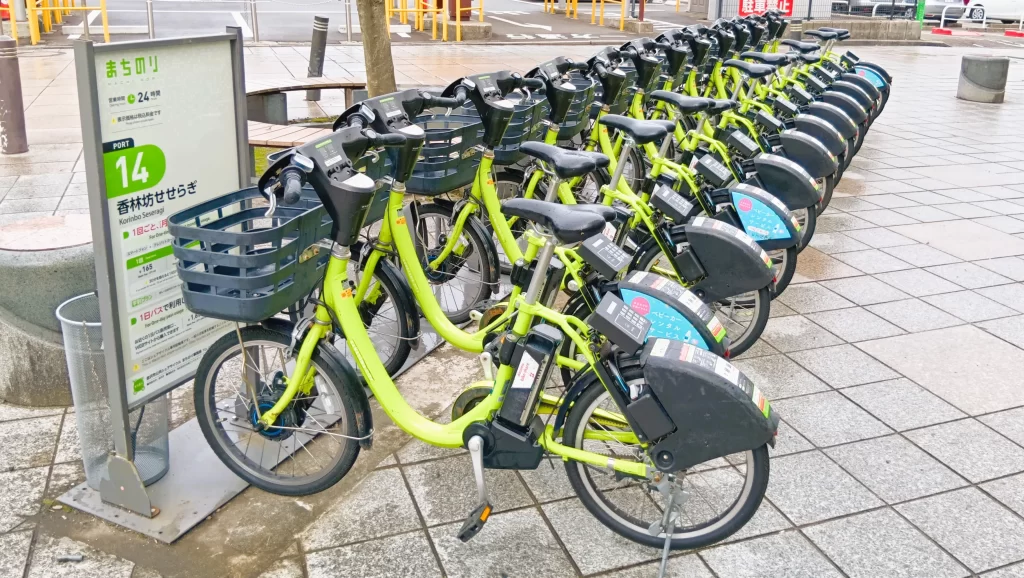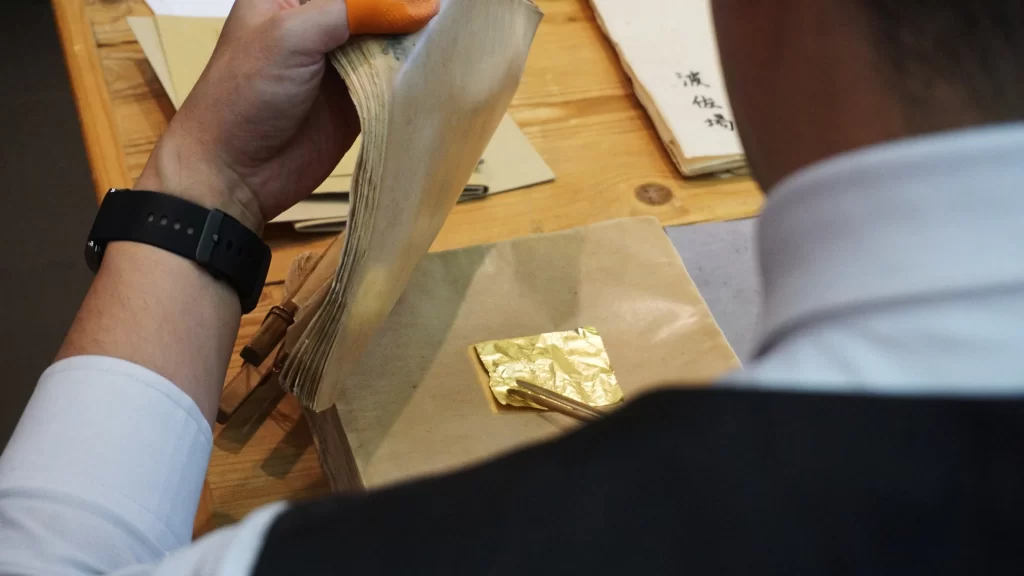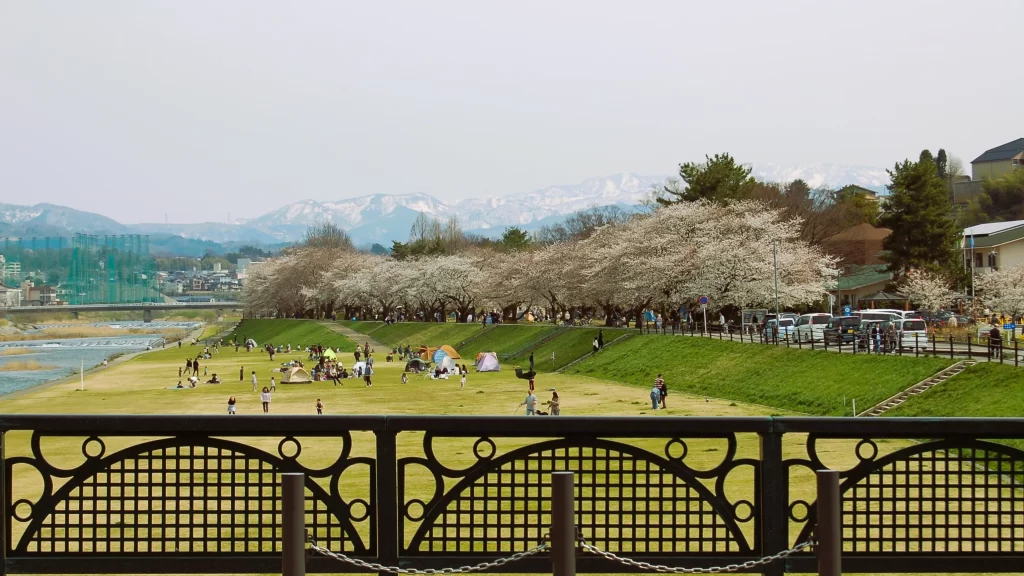
KANAZAWA
Cycling in Kanazawa & Beyond: The Smart Tourist’s E-Bike Guide

Welcome to the Cycling in Japan Course for First-timers! Hello to you, too, those of you who are soon-to-be reinitiated cyclists! Greetings, my fellow long-time cyclists (whose rulebook has gotten dusty or who haven’t kept up with recent changes to traffic laws)! Pull up a chair, everyone!
First things first. The one item you absolutely cannot ride without: a bicycle. I know it seems obvious and redundant to mention, but bicycle times are changing. Some Japanese cities, like Kanazawa, are offering more than just your basic rent-a-cycle; they offer electric bicycle (or e-bike) ride sharing. Here in Kanazawa, it’s called Machi Nori. (“Machi” means town and “nori means “ride”.)
Machi Nori use is widespread throughout the entire city. Download the app (you’ll need to connect it to a payment method, of course) from the Machi Nori website ( https://www.machi-nori.jp/en/ ) to locate the nearest docking station and check the number of bicycles available. You can even reserve a bicycle for up to 30 minutes if it’s the last one left and you absolutely must have it.
Adjusting the saddle height is a cinch and the bicycles themselves are in excellent condition. Before you choose a bicycle, press the power button and take a peek at the battery level to make sure you’ll have enough juice – 60% will easily get you from one sightseeing spot to another, even if you end up cycling up the steep hill next to Kenrokuen Garden. To be on the safe side, take a look at the tires, too, and make sure they’re inflated well. Next, follow the steps on the app to unlock your bike and you’re in business! The bike will be yours until you return it to one of the many Machi Nori bicycle stations in town. (Just make sure you lock it before you wander away!)
Tourists aren’t the only ones using Machi Nori – locals love it, too, for commuting to work or getting downtown for dinner and drinks. And the best part? The price. At a city-subsidized 165 yen ($1.25 USD or so) per 30 minutes, it’ll be the best value for your transportation-money in the country.
Now I realize that you’re all jazzed up to hop on an e-bike and cruise the streets, but this wouldn’t be much of a guide if we didn’t talk about safety. Accidents happen. They are a fact of life. So let’s make sure they don’t happen to you.
Helmets! As of 2024, all bicyclists should wear helmets. The police won’t give you a ticket if you don’t wear one, but if you have a chance to rent a helmet, do it. You’re on a strange bike in a strange place. The last thing you want is for a collision to land you in the hospital with a serious head injury.
Wear bright clothing! Nothing says “Hey, I’m riding here, buddy!” like neon yellow, traffic controller orange, and hot pink. Japanese elementary school kids wear bright yellow hats on their way to and from school every day to make them more visible. These days, they also stick their arm up in the air whenever they attempt a crosswalk, which brings us to our next nugget of advice…
Use hand signals! If you trust your balance and you have the bicycle under control, use your arms to signal which way you will be turning. Stick your right arm straight out to the side to signal a right-hand turn and stick out your left for a left-hand turn. And speaking of right and left…
Ride on the left! In Japan, traffic flows in the driver’s left-hand lane, which is the opposite of what many of us are accustomed to. Keep left while riding with traffic. If a sidewalk is wide enough and has a blue sign showing both a pedestrian and a bicycle on it, you can get off of the road and ride there.
Watch your speed! Slow it down on sidewalks as that’s where most bicycle accidents occur as people step out of homes and cars pull out of garages and parking lots.
Ride single file! Riding with your friends down the street side-by-side chorus-line style is a big no-no, especially since most Japanese streets do not have bicycle lanes or streets wide enough to paint a center line down the middle. If the road is a tight fit for cars, that’s all the more reason to hug the curb.
Don’t ring your bicycle bell at pedestrians! Pedestrians have the right of way – drivers yield to cyclists and cyclists yield to pedestrians. Even if they are plodding along down the middle of the sidewalk annoyingly staring at their smartphones, which brings us to–
Don’t use your smartphone while cycling! The police are on the lookout for this. Earbuds and headphones, too. In recent years, people who need some tunes for their ride have mounted small speakers on their bicycle handlebars. All the better to keep your ears perked for the soft purr of hybrid engines. So, it’s eyes on the road, ears on the traffic, and hands on the handlebars. (Sorry, no, you can’t brace your elbows on the handgrips while you eat fried noodles out of a plastic takeout box with wooden chopsticks. I’ve seen it done, yes… and the next day I saw the noodle-splat on the pavement.)
Alcohol and bicycles do not mix! It’s now illegal to ride a bicycle while intoxicated. Feel free to use a Machi Nori to get you to the bar, but plan to take a taxi home.
Don’t wear sandals! Your shoes need to be firmly on your feet, covering your toes and snug at your heels. Anything less is just asking for trouble.
One person per bicycle! Unless you have a little one who is riding in a professionally installed bicycle seat, your bicycle is not to be “shared” while it’s in motion. Teenagers with a death wish and no pain receptors in their backsides sometimes catch a ride on the rear luggage rack of their friend’s bicycle, but just trust me when I say this is not a good idea.
Last but not least, let your bicycle light light the way! If you’re riding sometime around dawn or dusk or through the darkness in between, make sure your bicycle light is on regardless of the brightness of the streetlamps.
These guidelines should get you through riding in and around well-populated areas. If you’re going to be cycling in rural or mountainous areas, try to avoid riding during the hours bracketing sunrise and sunset as these are when most bear and wild boar sightings occur. Cyclists are not usually targeted, but it’s best to avoid upsetting the unpredictable wildlife if you can.
So that’s it! You’re all set. Take care, have fun, and enjoy the ride!
This article was written by Keri Yazawa
About Keri Yazawa
Keri Yazawa has been a resident of Kanazawa City since 2005 and enjoys cycling, stamp-making, and tofu!

©Keri Yazawa



